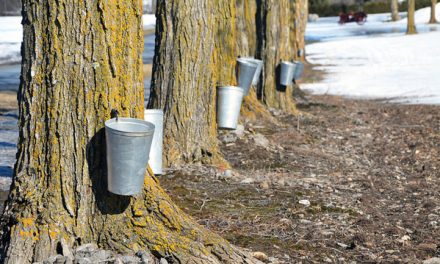Fifty sheep producers toured local facilities. Courtesy Photo
By Colleen Acres
AgriNews Contributor
On Oct. 23, fifty sheep producers from across Eastern Ontario joined together to visit seven area sheep farms and learn about different ways to manage sheep.
Producers discussed infrastructure, nutrition, marketing, management and challenges like predation and parasites. Some very generous host farms shared their successes and their challenges and the interested and engaged participants raised lots of great questions. Some brief highlights profiling the host farms follows.
Located near Winchester, Sarah Holmes and Conner Fetterly showed their recent acquisition of some of the Canadian Arcott breeding stock originating out of the AAFC breeding program of this unique Canadian breed. With a new fabric covered building in the works, they shared their future industry goals and plans to grow their flock.
Celeste Lacroix and Brian Epp were the next stop on the tour. Moving to a 100-acre Farm near Jasper, Ont. area from British Columbia within the last six years, they shared how they had used WOOFers (Worldwide Opportunities on Organic Farms) to help fence their 100-acre farm for sheep, seed down new pasture and hayland. Celeste demonstrated her vast knowledge on training and working with Border collies to manage their flock. Brian and Celeste travel with their dogs attending trials and also work at training and helping others to use Border collies to move and manage their sheep flocks.
Valentijn Farm near Smiths Falls welcomed participants and shared their dairy sheep operation with the group. Using both East Friesen and Romanov Ewes they market the fluid milk to Back Forty Cheese factory. Lambs are sold at local auction market and the best ewe lambs are retained to grow their flock. The Romanov’s were added to increase the flock prolificacy and the F1 cross ewes are increasing the milk production also. They also showed their bucket raising system for the lambs using Jersey cow milk.
Elaine and Gwyneth Oosting from Lombardy raise llama’s for predator protection on their 200 ewe flock. A small century old bank barn is used for lambing out ewes in February and then ewes and lambs are moved to a grouping of outdoor pens with wooden panels and three-sided shelters. Dry ewes are moved offsite during the summer to an area solar farm where they are contracted to manage the grass growth and keep the solar panels free from shading.
They added a second small solar site this year and raised yearling ewes with their April born lambs at this site. They shared some of the learning curves with this production system as well as their rotational grazing practices.
Over near Seeley’s Bay, Brian and Emily Voith are raising Rideau Arcotts in Emily’s parents former dairy cow barn. Brian’s manufacturing skills were on display with a locking headgate system that helps them vaccinate ewes in the lambing barn setup. Across the road is the lamb feedlot as well as a new fabric covered barn currently under construction that will allow them to expand the flock up to 400 ewes. Brian and Emily are using light control to stimulate ewes into estrus and allow them to run an accelerated lambing system. A group of nearly 100 Rideau ewes were lambing in October and those ewes had previously lambed in January of 2021.
Black Creek Ranch is owned and operated by Brad and Karen Davis and family. Originally wanting to purchase a dairy cow farm, this couple shared their journey into how they came to purchase an ongoing large pasture-based sheep operation in 2012 and the changes they have made since that time. Using Border Cheviot ewes and some added Romanov genetics, the flock has grown to 950 ewes and lambs annually in mid-May.
Karen shared information on using teaser rams with their ewe lambs to shorten and tighten the lambing schedule. Brad showed the bale unrolling feeding system used in the winter that is drawn by draft horses and discussed their lamb marketing where they haul over 100 lambs at a time in their double deck trailer to OLEX in November, December, January to capture some of the prime price opportunities available.
Thank you to terrific host farms who shared their vast knowledge and to the tour participants who joined in on a great learning opportunity about the diversity of options available in managing sheep operations.













